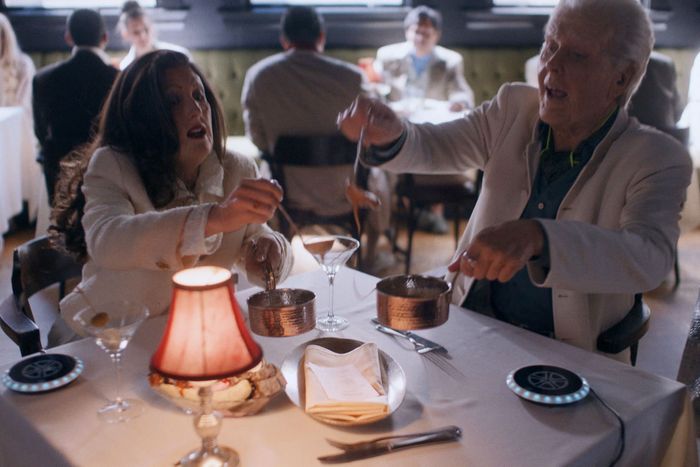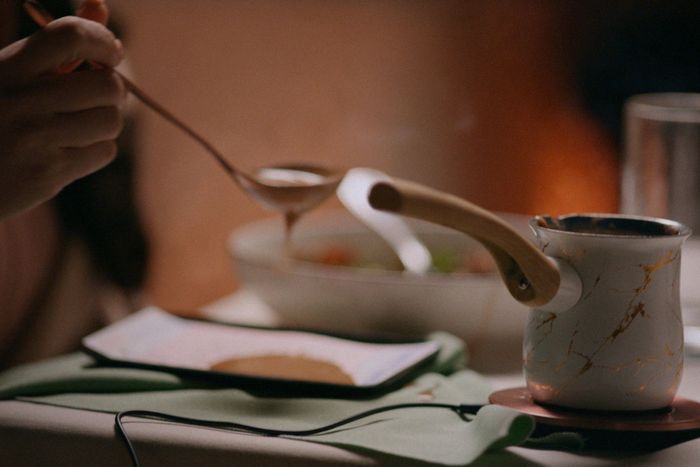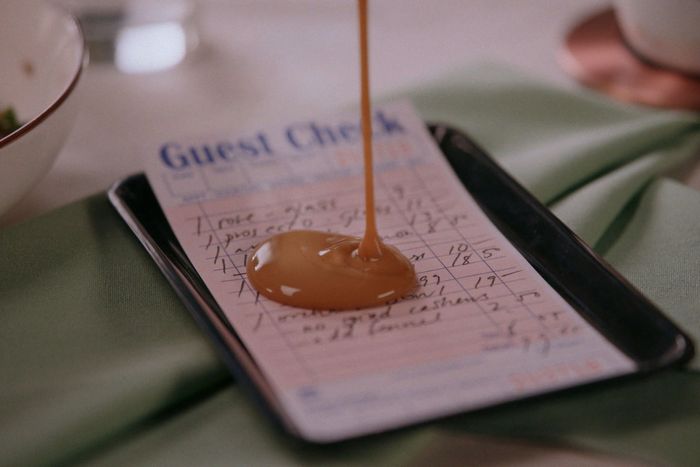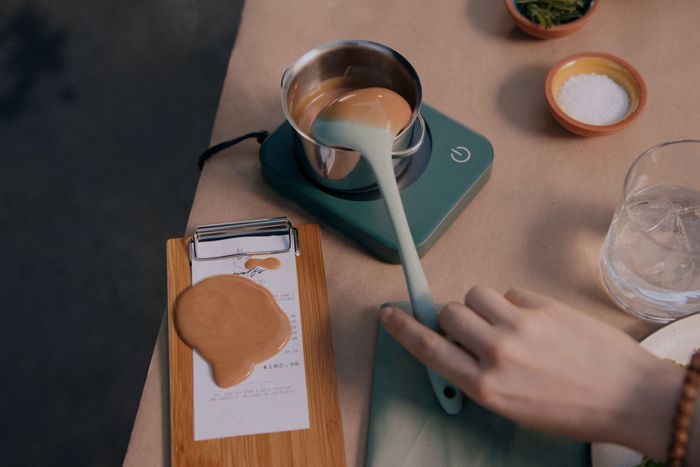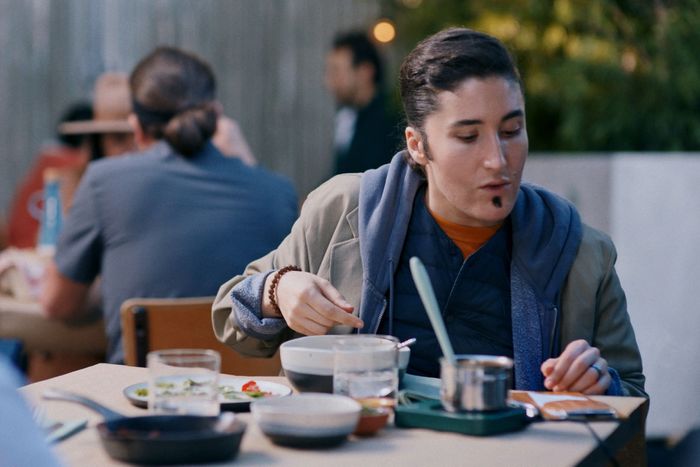
A couple of tech bros, well-off guys in their 30s, are wrapping up lunch at an outdoor café. One of them talks about home renovations while the other scrolls through his phone. Their server comes by with the check, and after the usual dick-measuring back-and-forth of who’s picking up the tab, the one with the goatee (played by Kate Berlant) asks, “Do you take hot caramel?” They do, obviously. It’s like asking if they take Apple Pay, only it’s hot caramel. As the guy reads over the check and adds up the tip, he drops little cubed candies into a small pot on a hot plate, waits for it to heat up to a rolling boil, and ladles it onto the total, mostly in total silence.
This little piece of surrealist theater is the first of four hot-caramel cameos in Berlant and John Early’s new Peacock comedy special, Would It Kill You to Laugh? All of these sketches take place in a world almost entirely like ours, the main differences being Berlant and Early’s global megastardom as the estranged leads of the beloved sitcom He’s Gay, She’s Half-Jewish and the use of melted caramel as currency. The second sketch comes halfway through the special and ends with a server scalding his hand and screaming when he collects the check. The third is a short interstitial in which Early tips a stripper (Berlant) by spooning a drizzle of caramel onto the stage. The final one takes place in the future, when the He’s Gay, She’s Half-Jewish stars reconvene at a white-tablecloth establishment, hoping to be recognized and splitting the check in caramel. The running gag feels like a spiritual cousin to the hot-dog-fingers world in Everything Everywhere All at Once, the maddest of multiverses, and it’s as funny as it is mystifying. Berlant and Early went deep on the origins of the running bit, the surprisingly elaborate special effects required to pull it off, and why hot caramel is the new crypto.
Why caramel?
John Early: Why caramel, Kate?
Kate Berlant: Why not caramel? That’s an inside joke from way back when John and I would just be at a restaurant. Restaurants are very loaded for us. We love going to restaurants, but we always are very fixated on our waiter loving us and disappointed if our waiter doesn’t love us. We had lunch a couple of days ago at Langer’s, and we loved the waiter and wanted him to love us. At the end of the meal, he said, “You guys have been great,” and we could have cried.
Anyway, we always had this joke where we imagined ladling hot caramel onto a check. It was this visual joke and this thing that we thought was so funny, and we decided to double down, insist upon it, and put it into the special. There kind of isn’t anything there beyond the fact that it made us privately laugh.
JE: It’s an audio joke, too. There’s something very funny about saying, “Do you guys take hot caramel?” “Hot caramel”: You have to wrap your mouth around the words very aggressively to say it. But then we realized in the special that it’s a great vehicle for us to do some of our own favorite dynamics around money anxieties and restaurant anxieties too.
Do you ever run the risk of overcorrecting when you’re performing how good of a customer you are?
KB: That’s the line we’re always trying to walk, and I think we do it well. When you dine with someone and they’re self-flagellating — like they’re so uncomfortable with the power dynamic that their response is almost to belittle or condescend — it becomes this really preening “So sorry, do you mind?” Going overboard like that is so grotesque to us. So the answer is yes, you actually can go too far. We go really far in the direction of trying to appear perfect.
JE: I think we’ve crossed the line. We’ve been friends for a long time, so we’ve had many opportunities to go too far where we’re being extra reverent. We’re almost sending up the formality of the dining experience. And every once in a while we’ll get a waiter who doesn’t find it funny.
KB: And it’s so hard.
JE: It’s so hard, and we’ll talk about it for weeks.
Do you ever feel like you’re on the other side of that dynamic when you’re approached by fans?
KB: We just love it, right, John?
JE: Yeah.
KB: Nothing about that interaction makes us uncomfortable. To be clear, I want adoration, so nothing about being adored is uncomfortable to me.
JE: The last sketch is very much based on real dynamics — not just with waiters but with people in public, where we’ll see someone of a certain kind of a certain kind of milieu, and we’ll be like, “Well there’s no way they’re not fans.” And we’ll spend a good 30 minutes dissecting every little glance over to us, like, “Was that an accident, or were they trying to very politely clock us?” So that last sketch comes from a very real place, embarrassingly enough.
And you don’t know the true origin of when the caramel joke began?
JE: I have a memory, actually. I think it was at Sweetwater in Williamsburg.
KB: Wow, that sounds about right.
JE: It would have been in the late summer of 2012, which was the beginning of our friendship. To be clear, May 5, 2012, is our anniversary. But at this point in the friendship, I feel like we were a little deeper into it. I think we said it to our waiter.
KB: “Do you take hot caramel?”
JE: And then we were just dying, thinking of the scooping of the ladle and the sound that would make, getting the check. Then it was the fun of imagining how different people from different social groups would have different caramel paraphernalia.
Your character asking if they take hot caramel implies that there are still other forms of payment in this world, yet you’re opting for this one.
KB: Maybe they’ve just consolidated their assets into caramel. In my mind, it’s a fad that some people are still really clinging to.
JE: These are associations that we’ve made after the fact. It started as something that was very instinctively funny to us, and then it was only right before we shot where we were realizing the obvious associations with cryptocurrency. We’re delighted by that association that people seem to be making. The first time it appears with those two men, that was just us wanting to play those tech-world start-up bros. But the caramel specifically paired with those two does highlight its crypto association. But if you do look closely, there are outlets on the other tables. You may not see people paying with caramel, but it is a world in which that is an option, and a very popular option. The girls, too — I feel like it makes sense that they would be paying with “trendy” crypto. And then our characters at the end, it seems to be something from the past that they’re holding on to.
What were the director and production designer’s reactions to the hot-caramel concept when you brought it to them?
KB: We’ve worked with Andy DeYoung a lot and he really knows us, so there isn’t a need to translate much or explain. The joke is just received, which is a blessing.
JE: Our production designer, Grace Alie, and her prop team are amazing. They immediately saw the potential in a fake currency with all of its required accoutrement: You have to have some sort of device that can melt them down. You have to have the harder version before it’s melted. You have to have the scoop. They just immediately understood that there was a very big opportunity to choose the appropriate caramel technology for the character to reveal more about the character.
Like with the tech bros, there’s a sleek, almost camping-equipment vibe to the caramel stuff, like state-of-the-art outdoor REI hot-caramel technology. And then with the girls, it’s really rose gold, millennial pink, kind of “Instagram ad” caramel accoutrement. Then in the stripper moment, there’s that black-and-white checkered caramel thing, which I love. It feels very Chinatown. Then the old people, we had to have a kind of a nod to the future, so there’s a little bit of a space-age vibe with the lighting on the hot plate, but there’s also something very romantic about their copper, classic, dignified caramel instruments.
How many days were spent shooting?
KB: The whole special took five days.
Oh my God.
KB: It’s kind of amazing that we pulled it off, to be honest. There were a lot of times of us having to get things in one take. The guys with the caramel we had to get in so quickly.
JE: The sun was setting.
KB: There was a lot that was very, very rushed. The strip club was literally two minutes.
Was it actually caramel or some kind of substance?
JE: No, it was not caramel. It’s just so funny that these stupid ideas that you have end up requiring the hiring of both a visual-effects coordinator and post-visual-effects house, so this dinky little piece of punctuation for this little interstitial thing that we thought would be nothing required an in-person meeting with a really legit, sought-after guy that I guess A24 had on their roster who probably has done a lot of better things with his time. It was definitely some sort of chemical mixture that he made. He did melt down real caramel and then tried to match it to that color. Of course, caramel shifts. That’s the whole point; it gets more and more caramelized. So some of the color we actually did in postproduction to make it look more amber. And it was more milky in real life.
Berlant sent us the below behind-the-scenes video of three different “caramels” being tested and demonstrated:
Did the VFX guy get the humor of it?
JE: I don’t know. I mean, he was so sweet and professional and did such a beautiful job. It’s always hard to tell sometimes with technicians if they find what you’re doing inherently charming or if it’s just another day on the job. I think for him it was probably another maybe more bizarre day on the job.
Was the boiling also in post?
JE: No, he had a special tube that they somehow drilled into each pot, and he had a machine that they would turn up with a dial. It wasn’t real boiling.
Those moments of waiting for the caramel to come to a boil lead to more opportunities for awkward restaurant shenanigans.
JE: One of my favorite moments of Kate’s performance is when, as the man, she’s waiting for it to boil, and she’s so vulnerable because I’m on my phone.
We’ve arrived at the logic portion of the quiz. The checks in the sketches all have real numbers on them. What’s the caramel exchange rate?
KB: We don’t know!
JE: Do we adjust for inflation in the future?
In the sketch with the girls when Kate’s paying, every item on the menu seems to equal one caramel.
KB: Damn, yeah.
JE: I think you figured it out.
Is caramel scarce in this universe? Is that why it’s valuable?
KB: There might be a lot of it, which is why people are trying to offload it.
Every time the characters total up the check, they calculate. They measure enough caramel for the tip. They bring it to a boil. They ladle it into the thing. And there’s still leftover caramel melted in the pot, and they just leave it there!
KB: This was something that we, of course, struggled with. It’s too strong to say “struggled with.” We didn’t have time to care. Maybe there’s a world where … in a dream world … I don’t know, Rebecca.
JE: That was a hole in the logic. We really talked about this on set, though. We never thought this through. We knew the sketches would be funnier if we just got up and went.
KB: Maybe there is a whole job that we’ve never seen of a “caramel captain” or someone who, at the end of the night, goes through and reconsolidates the caramel and mails it to you. That’s all I’m gonna say.
How does staff split tips at the end of the night?
JE: They probably have silicone trays that are caramel cube shaped, and they’re pouring all the hot caramel into that at the end of every meal, and it’s hardening. They’re popping it out and splitting it like that.
John, your character in the second sketch gets out of paying with the excuse that she left her hot plate at home. In this world, can you not put your own caramel in someone else’s pot?
KB: I think in this world, it’s not socially acceptable to do that. Because then your caramel is melted into someone else’s pot, and it’s not polite to deal with “There’s a little remnant of mine” or whatever. So you bring your own hot plate. That’s just embedded in this culture.
JE: Also Kate’s character is being very generous in not probing any further because she knows that I just either fully can’t pay or she’s never gonna get to a place of honesty with me.
A different sketch sees you as beavers at the airport going through security, which makes me think of the TSA of it all. Is this allowed on a flight?
KB: I think caramel would be allowed.
And the gear?
KB: There are certain TSA guidelines for the hot plates, like you can’t have a live coil. It has to be electric.
JE: Or battery operated.
KB: We should’ve had some sign with a coil and a hot plate.
JE: And I imagine there’s kind of “traveler’s caramel,” where it’s not in a cube; it’s in smaller shapes, so you’re more flexible.
KB: Maybe pellets.
Would hot plates still not be allowed in dorm rooms in this world?
KB: Really good point.
JE: They would definitely not be allowed.
What does caramel mean to you guys?
KB: It’s decorative. It’s opulent. John is into caramel in real life. I’m actually not. I love a hot-fudge sundae, and I’ll take some caramel on it, but that’s not my flavor profile the way it is for John. I skew more chocolate.
JE: I’ve always been drawn to caramelization. To me, it has very old associations, which is why it really works for the two characters at the end. Butter pecan is kind of in that family. I love a brown-butter dulce de leche Häagen-Dazs ice cream.
KB: I love brown butter, too. I think chocolate is going to go extinct — it’s already on its way out — so caramel will be the predominant flavor, dessert-wise.
Your characters in the last scene are presented with a banana split. Is there caramel on that?
KB: No. I think there would be hot fudge, maybe butterscotch.
We can’t bring up butterscotch at this point or my brain is going to break.
KB: We can’t even introduce butterscotch into this world.
This interview has been edited and condensed.



